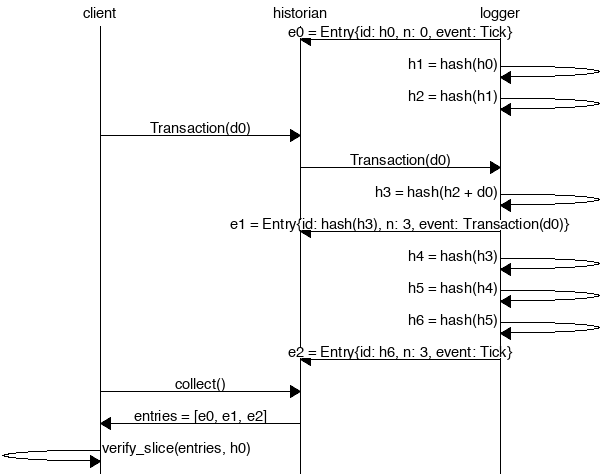2.2 KiB
2.2 KiB
The Historian
Create a Historian and send it events to generate an event log, where each entry is tagged with the historian's latest hash. Then ensure the order of events was not tampered with by verifying each entry's hash can be generated from the hash in the previous entry:
extern crate silk;
use silk::historian::Historian;
use silk::ledger::{verify_slice, Entry, Hash};
use silk::event::{generate_keypair, get_pubkey, sign_claim_data, Event};
use std::thread::sleep;
use std::time::Duration;
use std::sync::mpsc::SendError;
fn create_ledger(hist: &Historian<Hash>) -> Result<(), SendError<Event<Hash>>> {
sleep(Duration::from_millis(15));
let tokens = 42;
let keypair = generate_keypair();
let event0 = Event::new_claim(get_pubkey(&keypair), tokens, sign_claim_data(&tokens, &keypair));
hist.sender.send(event0)?;
sleep(Duration::from_millis(10));
Ok(())
}
fn main() {
let seed = Hash::default();
let hist = Historian::new(&seed, Some(10));
create_ledger(&hist).expect("send error");
drop(hist.sender);
let entries: Vec<Entry<Hash>> = hist.receiver.iter().collect();
for entry in &entries {
println!("{:?}", entry);
}
// Proof-of-History: Verify the historian learned about the events
// in the same order they appear in the vector.
assert!(verify_slice(&entries, &seed));
}
Running the program should produce a ledger similar to:
Entry { num_hashes: 0, id: [0, ...], event: Tick }
Entry { num_hashes: 3, id: [67, ...], event: Transaction { tokens: 42 } }
Entry { num_hashes: 3, id: [123, ...], event: Tick }
Proof-of-History
Take note of the last line:
assert!(verify_slice(&entries, &seed));
It's a proof! For each entry returned by the
historian, we can verify that id is the result of applying a sha256 hash to the previous id
exactly num_hashes times, and then hashing then event data on top of that. Because the event data is
included in the hash, the events cannot be reordered without regenerating all the hashes.
